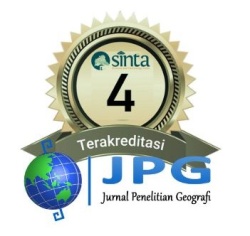Peak Flood Discharge Analysis of the Gajah Wong Sub-Watershed, Indonesia
Abstract
Every year, during high rainfall, the Gajah Wong River overflows and inundates residential areas. The largest flood events on the Gajah Wong River occurred in early 2016 and mid-2016, this disaster caused the Gajah Wong River embankment to collapse, as a result the floods continued to overflow and enter residents' settlements as high as 2 meters. This is because the capacity of the river exceeds the peak discharge. This study aims to calculate the peak discharge using the rational method by utilizing data on daily maximum rainfall in the range from 2001 to 2021. The results of the study show that there was an increase in the inundation area for each flood return period. The peak flood discharge in the Gajah Wong River Segment using the rational method respectively for return floods of 2, 5, 10, 25 and 50 years is 61.41 m3/second, 98.94 m3/second, 123.79 m3/second , 155.18 m3/second and 178.46 m3/second.
KEYWORDS: Flood; Hec-RAS; Gajah Wong.
Full Text:
PDFReferences
Ardiansyah, A., & Sumunar, D. R. S. (2020). Flood vulnerability mapping using geographic information system (GIS) in Gajah Wong sub watershed, Yogyakarta County Province. Geosfera Indonesia, 5(1), 47. https://doi.org/10.19184/geosi.v5i1.9959
Asdak, C. (2014). Hidrologi dan pengelolaan daerah aliran sungai (Edisi ke-6). Gadjah Mada University Press.
Che, D., Liang, A., Li, X., & Ma, B. (2018). Remote sensing assessment of safety risk of iron tailings pond based on runoff coefficient. Sensors, 18(4), 1045. https://doi.org/10.3390/s18041045
Chow, V. T., Maidment, D. R., & Mays, L. W. (1988). Applied hydrology. McGraw-Hill.
Clark, M. P., Bierkens, M. F. P., Samaniego, L., Woods, R. A., Uijlenhoet, R., Bennett, K. E., ... & Peters-Lidard, C. D. (2017). The evolution of process-based hydrologic models: Historical challenges and the collective quest for physical realism. Hydrology and Earth System Sciences, 21(7), 3427–3440. https://doi.org/10.5194/hess-21-3427-2017
Costabile, P., Costanzo, C., Ferraro, D., Macchione, F., & Petaccia, G. (2020). Performances of the new HEC-RAS version 5 for 2-D hydrodynamic-based rainfall-runoff simulations at basin scale: Comparison with a state-of-the-art model. Water, 12(9), 2326. https://doi.org/10.3390/w12092326
Dawson, R. J., Speight, L., Hall, J. W., Djordjevic, S., Savic, D., & Leandro, J. (2008). Attribution of flood risk in urban areas. Journal of Hydroinformatics, 10(4), 275–288. https://doi.org/10.2166/hydro.2008.054
Edwards, P. J., Williard, K. W. J., & Schoonover, J. E. (2015). Fundamentals of watershed hydrology. Journal of Contemporary Water Research & Education, 154(1), 3–20. https://doi.org/10.1111/j.1936-704X.2015.03185.x
Hadisusanto, N. (2011). Aplikasi hidrologi. Jogja Mediautama.
Hari Murtiono. (2008). Kajian model estimasi volume limpasan permukaan, debit puncak aliran, dan erosi tanah dengan model Soil Conservation Service (SCS), Rasional dan MUSLE (Studi kasus di DAS Keduang, Wonogiri). Kelompok Peneliti Konservasi Tanah dan Air, Balai Penelitian Kehutanan Solo.
Harisuseno, D., & Bisri, M. (2017). Limpasan permukaan secara keruangan (spatial runoff). UB Press.
Indarto. (2010). Hidrologi: Dasar teori dan contoh aplikasi model hidrologi. Bumi Aksara.
Ismail, A. (2009). Pengaruh perubahan penggunaan lahan terhadap karakteristik hidrologi daerah tangkapan air Waduk Darma, Kabupaten Kuningan, Provinsi Jawa Barat [Tesis, Universitas Indonesia].
Istiarto. (2014). Simulasi aliran 1-dimensi dengan bantuan paket program hidrodinamika HEC-RAS. Modul Pelatihan.
Kodoatie, R. J. (2013). Rekayasa dan manajemen banjir kota. Andi Offset.
Konrad, C. P. (2003). Effects of urban development on floods. USGS Science for a Changing World.
Lee, S., Kim, J., Jung, H., Lee, M. J., & Lee, S. (2017). Spatial prediction of flood susceptibility using random-forest and boosted-tree models in Seoul metropolitan city, Korea. Geomatics, Natural Hazards and Risk, 8(2), 1185–1203. https://doi.org/10.1080/19475705.2017.1308971
Linsley, R. K., Kohler, M. A., & Paulhus, J. L. H. (1996). Hidrologi untuk insinyur (Edisi ke-3). Erlangga.
Marfai, M. A. (2003). GIS modelling of river and tidal hazards in a waterfront city: Case study Semarang [Thesis, ITC, The Netherlands].
Nurrizqi, E. H. (2016). Model pemanenan air hujan (rainwater harvesting) untuk mengurangi dampak bencana banjir di DAS Penguluran, Kecamatan Sumbermanjing Wetan, Kabupaten Malang [Skripsi, Universitas Gadjah Mada].
Papaioannou, G., Loukas, A., Vasiliades, L., & Aronica, G. (2016). Flood inundation mapping sensitivity to riverine spatial resolution and modelling approach. Natural Hazards, 83(1), 117–132. https://doi.org/10.1007/s11069-016-2382-1
Pekel, J. F., Cottam, A., Gorelick, N., & Belward, A. S. (2016). High-resolution mapping of global surface water and its long-term changes. Nature, 540(7633), 418–422. https://doi.org/10.1038/nature20584
Putra, A. H., & Febrianti, Y. (2020). Analisis banjir dengan metode SCS-CN menggunakan Sistem Informasi Geografis (SIG) di Kecamatan Pauh Kota Padang. Jurnal Ilmiah Rekayasa Sipil, 17(1), 1–11. https://doi.org/10.30630/jirs.v17i1.39
Rahadi, B., & Harimurti, R. (2016). Pemodelan banjir DAS Citepus akibat perubahan penggunaan lahan dan desain polder menggunakan HEC-HMS dan HEC-RAS. Jurnal Teknik ITS, 5(2), A296–A300. https://doi.org/10.12962/j23373539.v5i2.18337
Razi, M. A. M., Ariffin, J., & Tahir, W. (2010). Flood estimation studies using hydrologic simulation program-FORTRAN (HSPF) model. American Journal of Environmental Sciences, 6(3), 238–243. https://doi.org/10.3844/ajessp.2010.238.243
Rimba, A. B., Setiawan, B., Vidiarina, H. D., & Rahayu, H. (2022). Flood hazard mapping using HEC-RAS and GIS spatial analysis in Cimandiri River. IOP Conference Series: Earth and Environmental Science, 1041, 012065. https://doi.org/10.1088/1755-1315/1041/1/012065
Saputro, E. A., & Hermawan, H. (2021). Simulasi debit sungai menggunakan metode HEC-HMS pada Sungai Penggung, Desa Ngringo, Kecamatan Jaten, Kabupaten Karanganyar. Jurnal Teknik Sipil dan Perencanaan, 23(2), 63–74. https://doi.org/10.15294/jtsp.v23i2.31379
Setiawan, R. Y., & Rosyidi, A. (2020). Pemodelan banjir dengan metode HEC-RAS dan HEC-HMS di DAS Cipinang. Jurnal Teknik Sipil, 11(1), 45–52. https://doi.org/10.21070/jts.v11i1.657
Suripin. (2004). Sistem drainase perkotaan yang berkelanjutan. Andi.
Tarigan, S. D., & Yulianti, M. (2020). Simulasi limpasan permukaan menggunakan metode HEC-HMS di Daerah Aliran Sungai Cisadane Hulu. Jurnal Teknik Sipil, 8(2), 117–127. https://doi.org/10.32722/jts.v8i2.3162
Triatmodjo, B. (2008). Hidrologi terapan. Beta Offset.
Yulianur, Y., & Saputra, D. D. (2022). Analisis banjir pada sungai Kreung Aceh dengan metode HEC-RAS dan HEC-HMS. Jurnal Teknik Sipil, 11(1), 13–21. https://doi.org/10.25077/jts.11.1.13-21.2022
Refbacks
- There are currently no refbacks.
INDEX JOURNAL


















